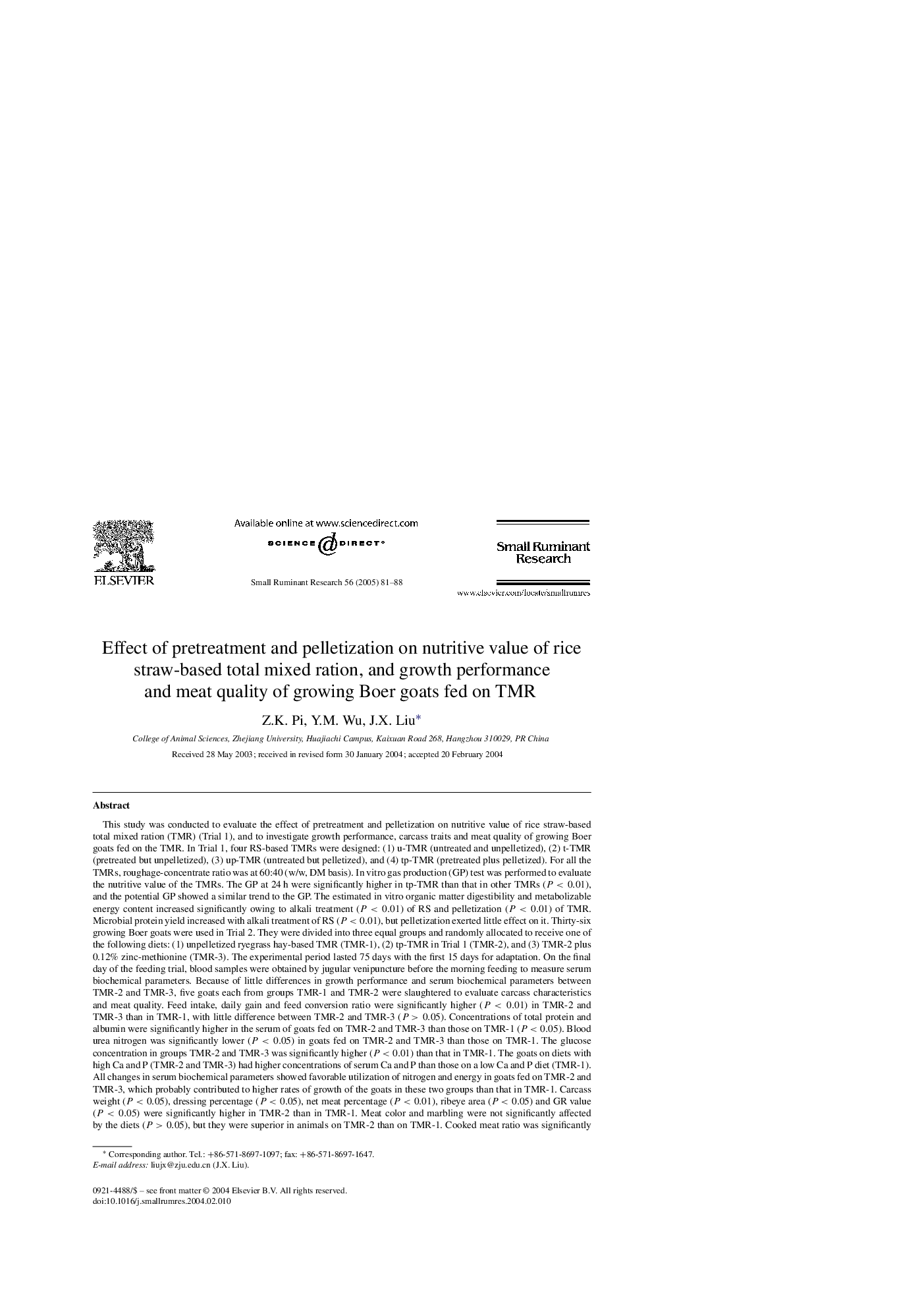| کد مقاله | کد نشریه | سال انتشار | مقاله انگلیسی | نسخه تمام متن |
|---|---|---|---|---|
| 8986815 | 1554436 | 2005 | 8 صفحه PDF | دانلود رایگان |
عنوان انگلیسی مقاله ISI
Effect of pretreatment and pelletization on nutritive value of rice straw-based total mixed ration, and growth performance and meat quality of growing Boer goats fed on TMR
دانلود مقاله + سفارش ترجمه
دانلود مقاله ISI انگلیسی
رایگان برای ایرانیان
کلمات کلیدی
موضوعات مرتبط
علوم زیستی و بیوفناوری
علوم کشاورزی و بیولوژیک
علوم دامی و جانورشناسی
پیش نمایش صفحه اول مقاله

چکیده انگلیسی
This study was conducted to evaluate the effect of pretreatment and pelletization on nutritive value of rice straw-based total mixed ration (TMR) (Trial 1), and to investigate growth performance, carcass traits and meat quality of growing Boer goats fed on the TMR. In Trial 1, four RS-based TMRs were designed: (1) u-TMR (untreated and unpelletized), (2) t-TMR (pretreated but unpelletized), (3) up-TMR (untreated but pelletized), and (4) tp-TMR (pretreated plus pelletized). For all the TMRs, roughage-concentrate ratio was at 60:40 (w/w, DM basis). In vitro gas production (GP) test was performed to evaluate the nutritive value of the TMRs. The GP at 24Â h were significantly higher in tp-TMR than that in other TMRs (P<0.01), and the potential GP showed a similar trend to the GP. The estimated in vitro organic matter digestibility and metabolizable energy content increased significantly owing to alkali treatment (P<0.01) of RS and pelletization (P<0.01) of TMR. Microbial protein yield increased with alkali treatment of RS (P<0.01), but pelletization exerted little effect on it. Thirty-six growing Boer goats were used in Trial 2. They were divided into three equal groups and randomly allocated to receive one of the following diets: (1) unpelletized ryegrass hay-based TMR (TMR-1), (2) tp-TMR in Trial 1 (TMR-2), and (3) TMR-2 plus 0.12% zinc-methionine (TMR-3). The experimental period lasted 75 days with the first 15 days for adaptation. On the final day of the feeding trial, blood samples were obtained by jugular venipuncture before the morning feeding to measure serum biochemical parameters. Because of little differences in growth performance and serum biochemical parameters between TMR-2 and TMR-3, five goats each from groups TMR-1 and TMR-2 were slaughtered to evaluate carcass characteristics and meat quality. Feed intake, daily gain and feed conversion ratio were significantly higher (P<0.01) in TMR-2 and TMR-3 than in TMR-1, with little difference between TMR-2 and TMR-3 (P>0.05). Concentrations of total protein and albumin were significantly higher in the serum of goats fed on TMR-2 and TMR-3 than those on TMR-1 (P<0.05). Blood urea nitrogen was significantly lower (P<0.05) in goats fed on TMR-2 and TMR-3 than those on TMR-1. The glucose concentration in groups TMR-2 and TMR-3 was significantly higher (P<0.01) than that in TMR-1. The goats on diets with high Ca and P (TMR-2 and TMR-3) had higher concentrations of serum Ca and P than those on a low Ca and P diet (TMR-1). All changes in serum biochemical parameters showed favorable utilization of nitrogen and energy in goats fed on TMR-2 and TMR-3, which probably contributed to higher rates of growth of the goats in these two groups than that in TMR-1. Carcass weight (P<0.05), dressing percentage (P<0.05), net meat percentage (P<0.01), ribeye area (P<0.05) and GR value (P<0.05) were significantly higher in TMR-2 than in TMR-1. Meat color and marbling were not significantly affected by the diets (P>0.05), but they were superior in animals on TMR-2 than on TMR-1. Cooked meat ratio was significantly higher (P<0.05) and drip loss was lower (P<0.05) for goats on TMR-2. It is inferred that pelletization in addition to alkali treatment is a prosperous way to upgrade and utilize rice straw efficiently in ruminant diets.
ناشر
Database: Elsevier - ScienceDirect (ساینس دایرکت)
Journal: Small Ruminant Research - Volume 56, Issues 1â3, January 2005, Pages 81-88
Journal: Small Ruminant Research - Volume 56, Issues 1â3, January 2005, Pages 81-88
نویسندگان
Z.K. Pi, Y.M. Wu, J.X. Liu,